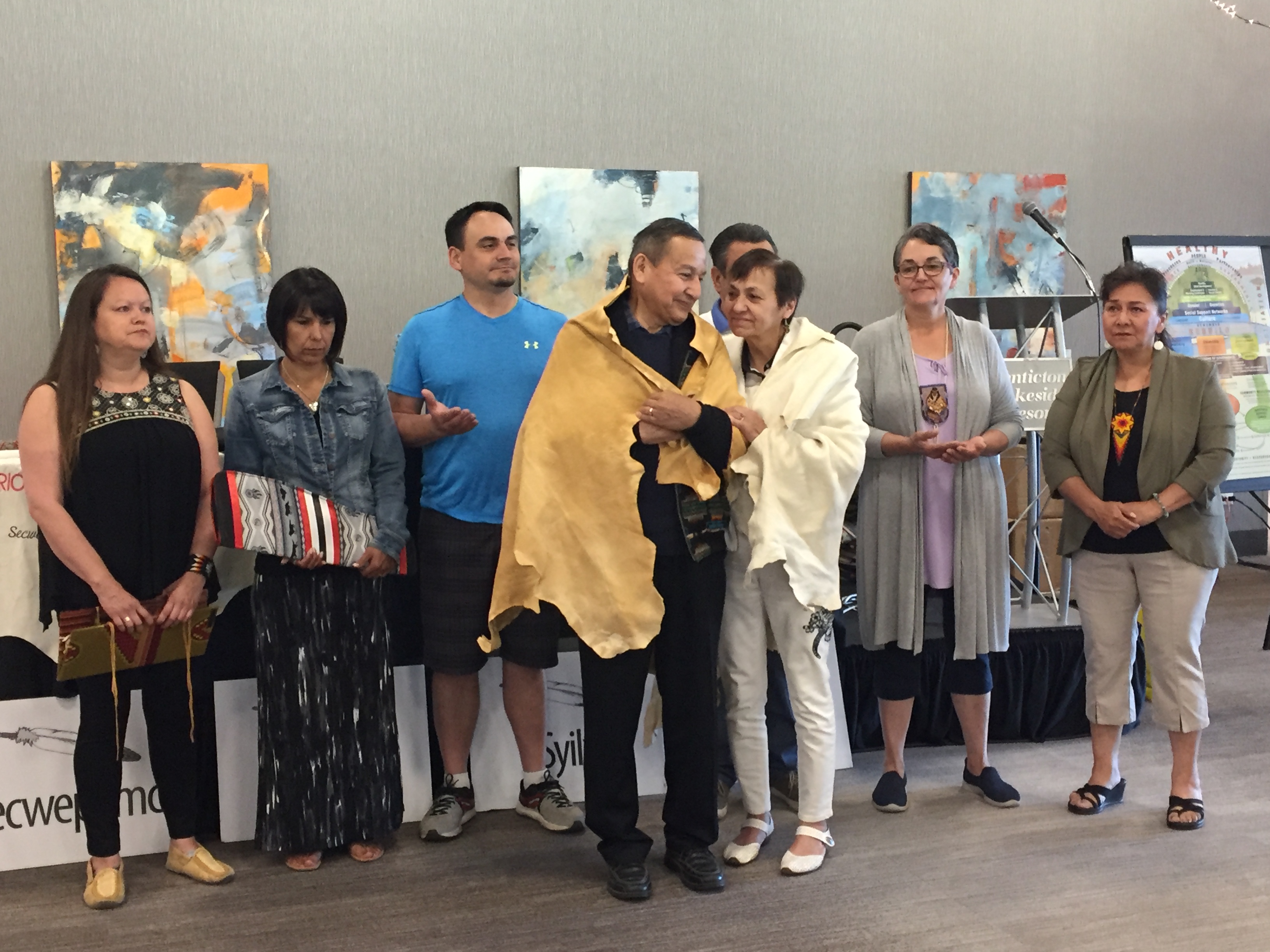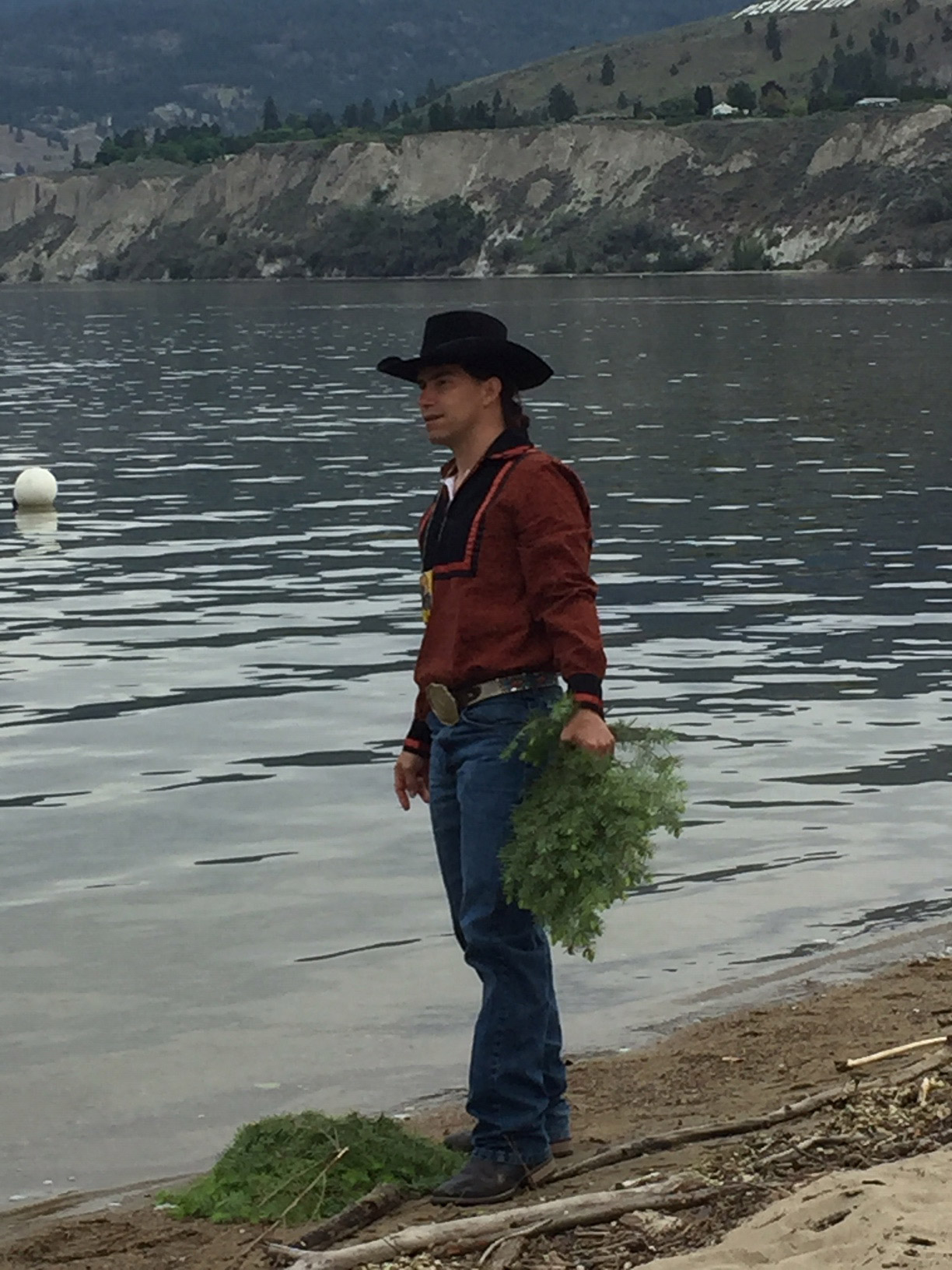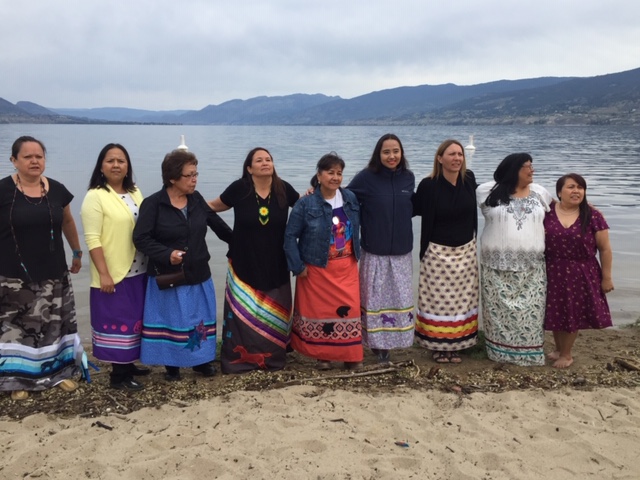The elements – in particular water and fire – played a key role at the 2019 FNHA Interior Region Governance Caucus held May 14 - 15.Political and health leaders from the Dãkelh Dené, Ktunaxa, Nlaka'pamux, Secwepemc, St'át'imc, Syilx and Tsilhqot'in gathered in Penticton, Syilx Territory, where the caucus opened with a water ceremony, led by Chief Chad Eneas and Elders of the Syilx Nation. Described as: “Interior Nations Circle of Strength: Celebration of Our Nations,” the ceremony closed with delegates sharing songs from each of their Nations.
Participants spent much of the first afternoon talking about fires and flooding with a panel discussion featuring representatives of the FNHA, Emergency Management BC, and Indigenous Services Canada (ISC). Nations held breakout sessions to identify gaps and priorities relating to emergencies.
Crystal Verhaeghe of the Tsilhqot’in Nation described how the wildfires disrupted her people’s spiritual, mental and physical well-being, so it was also a cleansing. Hence the name of that Nation’s comprehensive report on wildfire management: The Fires Awakened Us that Crystal presented to the Caucus.
As Allan Louis, who co-chaired the caucus with Charlene Belleau, said: “This a theme that applies to much of what we do. We face disruptions, we face obstructions, we face crises whether they are wildfires or the opioid emergency. However, we face these fires – literal and metaphorical - with a growing circle of strength.”
Caucus delegates heard how their Nations are working together and with external partners to develop plans on a variety of fronts (see Snapshot below for more details) that reflect the needs, the culture, the wisdom and the knowledge of the Nations. As Doug Cochrane, Chair of Interior Health Board of Directors, said in describing the need for that health authority to work together with the Interior First Nations, “we can’t do it alone, we can’t be arbitrary, we need your advice and wisdom.”
In presenting the Interior Region Health and Wellness Plan Refresh, Gwen Phillips reminded delegates that wellness requires a strong sense of culture and finding the balance in going forward while honoring our traditions.
She said “All this work has to be founded on remembering who we are.”
Remembering who we are. That is how we build our circle of strength to go forward, how we will best protect our people and our territories.
INTERIOR CAUCUS SNAPSHOT
At a Glance
• The 155 participants included 29 chiefs and 21 proxies.
• This caucus focused on governance only – a new change for all regional caucuses in response to recommendations from delegates and leadership that conversations about political/governance topics be separated from technical/operational topics.
• Caucus business started with updates from the Interior Region Nation Executive and the Partnership Accord Leadership Table (PALT). The leadership passed motions approving the Regional Health and Wellness Plan Refresh and renewed Partnership Accord. The re-signing of the Partnership Accord will take place at the next PALT meeting in early June with a ceremony at the fall Caucus session.
• Chiefs supported an extension of Charlene Belleau’s term on the First Nations Health Council (FNHC) until October when there will be an election at the fall Caucus to appoint all three Interior representatives to the FNHC.
• Lisa Montgomery-Reid, Interior Regional Executive Director, reported on the region’s Bi-Annual Report that was included in the meeting packages.
• Colleen Erickson, FNHA Board Chair presented the FNHA Summary Service Plan highlighting recent work as well as key priorities for the FNHA in the year ahead. Read the Summary Service Plan here.
• Representatives of Indigenous Services Canada (ISC), Emergency Management BC (EMBC) and the FNHA committed to holding a meeting prior to the end of June to develop Nation-based tripartite MOUs (memoranda of understanding) on emergency management. These would be similar to the first-ever tripartite Collaborative Emergency Management Agreement signed in April 2018 between the Tsilhqot’in National Government, Indigenous Services Canada and the BC Government.
• Larry Marzinzik, Regional Coroner, and Lisa LaPointe, Chief Coroner, provided an overview of the role of the Coroner and how to escalate issues or bring forward positive stories. They said the BC Coroners Service continues to try to recruit First Nations coroners. Gwen Phillips suggested that each Nation look at identifying someone that may be interested in being trained for this role.
• Gwen Phillips reported on the recent Grandmother’s Gathering hosted by the Ktunaxa Nation where grandmothers discussed the need to assert their traditional roles as nurturers and healers. Gwen said the group is asking funders to ensure that resources come to the community level to start these conversations.
Infrastructure
• Grand Chief Doug Kelly, announced that the province and the FNHA will spend $40 million ($20 m each) to build or renovate six or seven treatment centres. That announcement was subsequently made at the FNHA’s First Nations Primary Care, Mental Health and Wellness Summit in Vancouver. Chief Kelly stressed the importance of capital and infrastructure, particularly water infrastructure for community use and firefighting; homes so children can stay in our communities; community detox facilities and treatment centres; and safe places for women experiencing family violence.
• Richard Jock, Chief Operating Officer of the FNHA, said there is a need for $90 million for community capital projects over four years but annual funding is only $10 million. The FNHA will explore various options to address the gap, including borrowing money; aggregating projects for economies of scale; working with the private sector and/or partnering with other organizations.
Primary Care
• Richard Jock announced a commitment to 17 First Nations-led primary care projects across regions over the next three years that will explore a team-based approach to services. “It’s an opportunity for First Nations to lead developments in the province.”
• He said that the FNHA will support initiatives to further enable access to primary care services, such as telehealth, networking supports, and medi-tech.
• Advocacy for First Nations equity in primary care networks engagement is planned.
• Announcement about a First Nations-led primary care initiative in Williams Lake is expected soon.
Alcohol and Drug Treatment
• Richard Jock reported on what are called “Non-NNADAP Subsidy Application Principles.” NNADAP is the National Native Alcohol and Drug Abuse Program. The new principles for Non-NNADAP subsidies are:
o FNHA-funded centres will be considered the first and primary option for addiction treatment
o Provincially-funded beds are the next option
o BC is now partnering on per diem payments in licensed and or registered treatment facilities off-reserve for individuals who are eligible for income assistance
o Any treatment centres funded through non-NNADAP must be licensed under the community care and assisted living act of registered with assisted living registrar
Opioid Data
• Dr. Shannon McDonald, Deputy Chief Medical Health Officer, provided an update on opioid health statistics for First Nations people in BC in advance of a joint announcement by the FNHA and the province May 27 to release this data provincially. The report says that while First Nations people make up 3.4% of BC’s population they account for 16.2% of overdose events – six times more than non- First Nations residents – and 12.8% of overdose deaths – 4.2 times more than other residents. Read the May 27 news release.
Health Benefits
• Benefits transfer. John Mah, Vice-President of Health Benefits for the FNHA, reported on the community engagement and other planning that is underway in preparation for the transition of health benefits from the federal government to the FNHA. As of September 16, Pacific Blue Cross will administer benefits on behalf of the FNHA for dental, vision, medical supplies and equipment, and drugs not covered by PharmaCare.
The transition will allow the FNHA to improve benefit coverage; reduce or remove much of the pre-determination requirements; and provide an administrative system that is more convenient for both clients and health care providers. John reported that dental benefits are the highest concern reported in the Interior region at community engagement discussions. In response to a query about when all the changes will be implemented, John said September 16 will be the start – not the end – of improvements to the benefits program. He said there will be ongoing engagement, evaluation and evolution of the program.
• Plan W. In response to queries and concerns about Plan W, John said there is ongoing evaluation of the program, including a third-party report that will be posted publicly when it is completed. Some new developments are imminent, including changes to diabetes medications (read the announcement).
• Shingles vaccine. John reported that a reimbursement policy for the new Shingrix shingles vaccine will be announced soon (read the announcement).
• Medical transportation. There were several queries about the MT benefits, with concerns that it isn’t extensive enough, especially given rising fuel costs. John said that MT will be reviewed following the transition of the other benefit areas this fall.
Jordan’s Principle
• Catherine Lappe, Regional Director General of BC for Indigenous Services Canada (ISC) spoke about the transition of the administration of the Jordan’s Principle program from the FNHA back to ISC. Jordan’s Principle is a bridge funding program to ensure there are no gaps in government services to First Nations children. The FNHA began administering the program in September 2017. However the program has expanded beyond health-related requests and now includes social and educational requests – putting its mandate beyond the FNHA’s jurisdiction. Some delegates expressed frustration that the transition has resulted in longer response times and a more bureaucratic process. Catherine said the program is still staffing up and employees are working closely with the FNHA to ensure smooth handoff.
Tribute to Grand Chief Stewart Phillip and Joan Phillip
• Day two of the Interior Governance Caucus started with a special honoring tribute to Grand Chief Stewart Phillip and his wife Joan Phillip. “We’re grateful for the sacrifices you and your family have made in your ongoing work… so our children can have landand a future and their culture,” said Caucus Co-chair Charlene Belleau as she introduced the tribute. In his response, Chief Phillip said: “We have a wonderful future in front of us. I’m really impressed with the work of the health council and all your collective hard work and the results you’ve achieved over the last decade or so. It’s Nation-based on that’s absolutely where our future lies – reclaiming our nationhood.”

Day two of the Interior Governance Caucus started with a special honoring tribute to Grand Chief Stewart Phillip and his wife Joan Phillip, who were wrapped in elk hides. Chief Michelle Edwards presented Stewart with an eagle feather and Loretta Williams presented Joan with a rattle. Stewart has served as President of the Union of BC Indian Chiefs since 1998. As Chief of the Penticton Indian Band from 1994 until 2008, as well as Chair of the Okanagan Nation Alliance, he has advocated for Aboriginal rights for the First Nations in the province and particularly in the Okanagan region. He was awarded the title Grand Chief by the Okanagan Nation in 2006 in honour of his lifetime of commitment to and work for Indigenous rights and title.

Chief Chad Eneas and Elders of the Syilx Nation reminded the gathering that water is crucial for our survival, and that we are collectively responsible for the health of critical elements like water.


